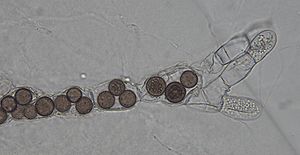Rozella
| Rozella | ||||||||||||
|---|---|---|---|---|---|---|---|---|---|---|---|---|

Rozella allomycis attacks a potty fungus from the genus Allomyces |
||||||||||||
| Systematics | ||||||||||||
|
||||||||||||
| Scientific name | ||||||||||||
| Rozella | ||||||||||||
| Cornu |
Rozella is a parasitic living genus of Opisthokonta .
features
The representatives are parasites and mainly attack Chytridiomycota and egg fungi . They grow inside their host as a trophic form without a cell wall. At a certain point in time, they transform into thick-walled resting pores or into zoosporangia without cell walls that fill the entire host cell. They are holocarp , so the whole thallus is transformed into the fruiting body.
At least the species Rozella allomycis has some ultrastructural peculiarities: The zoospores have a striped rhizoplast that connects the kinetosome (the basal body of the flagellum ) with a large, spherical mitochondrion . The latter borders on the helmet-shaped nucleus .
Systematics
Their taxonomic classification is controversial. In a molecular genetic study in 2006, Rozella and the Microsporidia formed the first clade to branch off from the other fungi :
| Mushrooms |
|
||||||||||||
|
|
Due to this lack of clarity, Rozella was later listed as incertae sedis within the fungi , i.e. not assigned to a higher taxon of the fungi.
Later investigations led to even more far-reaching results, according to which Rozella was no longer classified as part of the mushrooms in 2012, but instead forms a taxon called Nucletmycea together with the Nuclearia , Fonticula and the mushrooms .
species
Currently, 24 species are included in the genus Rozella :
Individual evidence
- ↑ a b Timothy Y. James, Peter M. Letcher, Joyce E. Longcore, Sharon E. Mozley-Standridge, David Porter, Martha J. Powell, Gareth W. Griffith, Rytas Vilgalys: A molecular phylogeny of the flagellated fungi (Chytridiomycota ) and description of a new phylum (Blastocladiomycota) . Mycologia, Volume 98, 2006, pp. 860-871.
- ^ TY James et al .: Reconstructing the early evolution of Fungi using a six-gene phylogeny . In: Nature , Volume 443, October 19, 2006, pp. 818-822. doi : 10.1038 / nature05110
- ↑ DS Hibbett et al .: A higher-level phylogenetic classification of the Fungi . In: Mycological research , May 2007; 111 (5): 509-547. Epub 2007 March 13, 2007. doi : 10.1016 / j.mycres.2007.03.004 , (PDF; 1.3 MB)
- ↑ Adl, SM, Simpson, AGB, Lane, CE, Lukeš, J., Bass, D., Bowser, SS, Brown, MW, Burki, F., Dunthorn, M., Hampl, V., Heiss, A. , Hoppenrath, M., Lara, E., le Gall, L., Lynn, DH, McManus, H., Mitchell, EAD, Mozley-Stanridge, SE, Parfrey, LW, Pawlowski, J., Rueckert, S., Shadwick, L., Schoch, CL, Smirnov, A. and Spiegel, FW: The Revised Classification of Eukaryotes. Journal of Eukaryotic Microbiology , 59: 429-514, 2012, PDF Online
- ↑ Rozella . Index fungorum. Retrieved November 8, 2009.